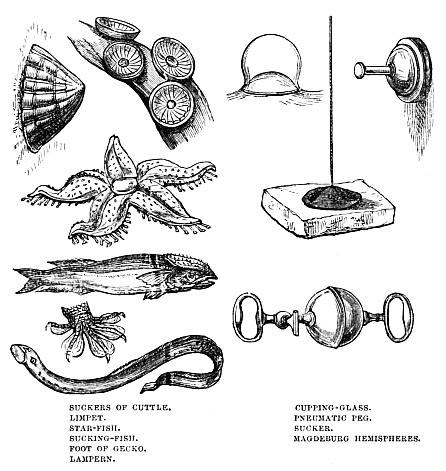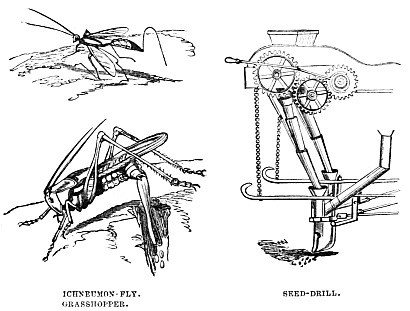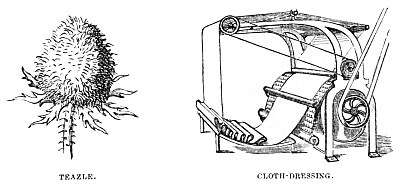 полная версия
полная версияNature's Teachings
This is, indeed, but a modification of the beautiful animal mechanism which keeps the teeth of a rodent animal always sharp, and always bevelled off at the proper angle. If we could invent some plan whereby, in our millstones, we could make the facing of much harder material than the stone, we should make an advance in the miller’s art that would render the millstones of the future as far superior to those of the present as are our present millstones to the hand “quern” of the Kafir women.
Yet another improvement has to be made. Would it be possible to construct a millstone which should not only retain its facing, but possess the power of renewing itself in proportion as it is worn out? This property is found in the Elephant’s tooth, and the illustration will give a tolerably good idea of the simple and beautiful mechanism by which it is brought into operation.
The tooth, instead of being one solid mass, consists, as I have already stated, of a series of plates set side by side. These plates are so constructed that they are more worn away in front than behind. In proportion as they are worn, a new tooth is built up behind the old one, and gradually pushes off the old one. Now, if we could only construct millstones with such properties, we should possess an absolutely perfect instrument.
Pressure of AtmosphereThere are many useful inventions which depend on the weight of the atmosphere and the creation of a more or less perfect vacuum. There is, for example, the common Pump, which raises water simply by the action of the atmosphere. A pipe passes into the water, and in that pipe an air-tight piston is inserted. When the piston is drawn upwards a vacuum is formed, and the water is at once forced into it by the pressure of the atmosphere.
Then there is the graceful and useful Napier Coffee-making Machine, consisting of a glass globe, and vase of the same material.
Coffee and boiling water are put into the vase, and some hot water into the globe. The two are then connected with the tube, and under the globe is placed a spirit-lamp. Presently the water in the globe boils, expelling the air and filling the globe with steam. The lamp is then removed, and the steam in the globe is condensed, leaving a vacuum. The pressure of the atmosphere then comes to bear upon the coffee in the vase, which is forced through the tube into the globe, producing beautifully clear and well-flavoured coffee.
Surgery employs the weight of the atmosphere in the operation called “Cupping,” now rarely employed, but formerly in such constant use that scarcely any man who had attained middle age had not undergone it. The operation was intended for the purpose of removing the blood from some definite spot. Persons, for example, who appeared to have a tendency to apoplexy were regularly cupped between the shoulders twice a year, i.e. in the spring and autumn.
The mode of performing the operation is as follows:—A vase-shaped glass vessel called a cupping-glass is placed close to the skin. The flame of a spirit-lamp is then introduced for a moment in the glass so as to expel the air, and the glass is rapidly placed with its mouth downwards on the skin. If this be done with sufficient rapidity, the partial vacuum in the cupping-glass causes it to adhere to the skin, which is forced into it by atmospheric pressure, as shown in the illustration. The blood is, of course, drawn towards the surface by the same means.
The glass is then quickly removed, and a little brass instrument applied, which, at the touching of a spring, sends out a number of small lancet-blades so formed as to make very slight cuts. The glass is again applied, and rapidly becomes filled with blood from the cuts, the air having forced it in exactly as it forces the coffee in Napier’s machine.
In the upper right-hand corner of the illustration is shown the Pneumatic Peg, a comparatively recent invention, and useful in cases where much strength is not required. The base of the peg is fitted with a sort of cup made of india-rubber. When this base is pressed against a smooth and flat surface, such as a pane of glass, the air is forced out of the cup, and a vacuum formed. The pressure of the atmosphere then causes the cup to adhere to the glass with sufficient force to enable objects to be suspended from it.
The boy’s well-known toy, the Sucker, is made on exactly the same principle. A piece of leather, generally circular, though the shape is not of much consequence, has a hole bored through its centre, so as to allow a string to be attached. The leather is then soaked in water until it is quite soft. If it be firmly pressed on any smooth object, such as a stone, the air is forced from under it, and it becomes capable of sustaining a weight in proportion to its dimensions. As the air has a pressure of about fifteen pounds on every square inch, it is easy to calculate the weight which it will uphold, a margin being left for imperfection of vacuum.

The lower figure represents the instrument called the Magdeburg Hemispheres, which are made for the purpose of showing the enormous power of air-pressure. They are two hollowed hemispheres, having their edges very accurately ground together. When used, a little lard is rubbed on the edges in order to insure their exact fit, and they are then pressed tightly together. The air is removed by means of the common exhausting syringe, and it is found that the two adhere together with such force that two strong men cannot pull them asunder. But, if the tap be turned, and air admitted, they come apart without the least difficulty.
Similarly, if two plates of glass or metal be ground to exactly plane surfaces, and pressed together, they adhere nearly as strongly as if they were one solid piece.
We will now turn from Art to Nature, and examine some natural producers of vacuum.
One of the most celebrated is that series of suckers which may be found upon the arms of the various Cuttles. At the upper part of the illustration a figure is given of part of an arm, on which are four suckers. When the animal wishes to attach itself to any object, it presses the disc of the sucker against it, and simultaneously withdraws the centre, exactly as the boy does with his toy sucker. And, as each arm contains a great number of suckers, it is evident that the holding power must be very great. Indeed, on one occasion when a comparatively small specimen had fastened on a man’s arm, he could not remove it, but was obliged to have it cut away piecemeal by an assistant.
The common Water-beetle has similar suckers upon its first pair of feet, and can adhere to smooth surfaces with great tenacity.
On the left of the cuttle-arm is the common Limpet, shown as it appears when adhering to the rocks. Every visitor to the seaside who has attempted to remove the Limpets may remember how difficult it is to stir them when they have once taken their hold. If they can be taken by surprise, they come away with a touch; but if they become alarmed, they press the edges of the foot firmly against the rock, withdraw the centre, and thus create the necessary vacuum.
Next follows a Star-fish, shown as it appears when in the act of walking, or rather, gliding along.
This movement is obtained by the use of a vast number of long suckers, exactly resembling the pneumatic peg, except that they are flexible, and can be curved in any direction. It is really beautiful to see the manner in which a Star-fish will glide along by means of its suckers, its arms accommodating themselves to the irregularities of the ground, and its multitudinous suckers protruded and withdrawn with a never-ceasing movement.
And, as the Star-fish is apparently blind, not having any organs which can even be conjectured to serve the purpose of vision, this mode of directing its course is not easily understood. Yet, blind though it may be, it guides itself with as much accuracy as if it possessed eyes, and evidently does so with a definite purpose, using its suckers with as much decision as a centipede uses its legs.
These suckers can be seen very well by placing a Star-fish in a shallow vessel of sea-water, and laying it on its back. The suckers immediately protrude themselves from their little apertures, and the arms slowly curve themselves so as to find something to which the suckers can adhere. Presently one or two of the suckers will take hold of the bottom of the vessel. Others soon follow, and in a very short time the Star-fish is on its legs, if we may so call them, and is quietly gliding on its way.
Below the Star-fish is seen the celebrated Sucking-fish (Echeneis remora) about which so many strange tales have been told, and which is possessed of a structure remarkable enough to need no aid from invention. The dorsal fin of this fish is modified in a most singular manner. The spines of which it is so largely composed are metamorphosed into flattened plates very much resembling the laths of a Venetian blind, and form an instrument of suction identical in principle, though not in form, with those which have already been described. When the sucker is pressed against a smooth surface, a vacuum is formed, and the fish in consequence adheres firmly to the object.
The fact has been known for centuries, though it has only been lately discovered, that the sucker was not a separate apparatus, but merely one of the fins modified in a simple though effective manner. Indeed, any one who has some slight notion of the structure of a fin can easily see, by looking at the Sucking-fish from above, that the apparatus is nothing more than the dorsal fin laid flat.
I may mention here that the name of Echeneis is taken from two words signifying “ship-holder.” It was given to the fish on account of a curious notion which was fully believed until quite modern times, that the Sucking-fish had the power of attaching itself to ships, and holding them so firmly that they could not proceed in spite of sails and oars. The word Echeneis is used by Aristotle in his “History of Animals.” The specific name remora, or “delay,” is Latin, and is given to the fish for the same reason.
The little Gobies, which are so plentiful along our coasts, have the ventral fins formed into a sucker, with which they can cling firmly to any object, such as a leaf of seaweed or a smooth rock or stone. A similar modification of the ventral fins is also found in the beautifully coloured Lump-fish, or Lump-sucker, sometimes called the Cock-paidle. One of these fishes, when placed in a bucket of water, adhered so strongly to the bottom, that, when lifted by the tail, it bore the whole weight of the pail and water.
Just below the Sucking-fish is drawn a foot of the curious little lizard, the Gecko, so called from its peculiar cry. It is common in the West Indies, and haunts houses, traversing their walls just as flies run up panes of glass. It is enabled to perform this movement by means of the structure of the feet. As the reader may see by reference to the illustration, the toes are greatly widened and flattened. If the lower surface be examined, it will be found to be furnished with a number of plates very much resembling those of the sucking-fish, and performing the same office.
So rapid is the operation of these plates, that the animal can even leap upon a perpendicular flat surface, and stick there. Perhaps the reader may remember that the beautiful Tree-frogs, which cling so tightly to leaves, are furnished with suckers on their toes, whereby they can hold on even to an upright pane of glass. In fact, the smooth surface of the glass seems to please them, and when they adhere to it they give an excellent opportunity of examining the structure of the feet with a magnifying-glass.
Another example of the pressure of the atmosphere has been slightly mentioned, when treating of the ball-and-socket joint. This is the joint by which the thigh-bone is attached to the hip. As the rounded head of the thigh-bone fits exactly into the cavity of the hip, and is, moreover, well lubricated with the animal oil called synovia, no air can obtain admission between the two. Consequently, they are held together so firmly by the pressure of the atmosphere, that they retain their places even after the whole of the muscular attachments have been removed. Not without very great force can the thigh-bone be dislodged from the shallow socket in which it lies; but, if a hole be bored so as to admit the air, it comes out at once.
Similarly, however firmly a limpet may cling to the rock, if the finest needle were introduced so as to admit air, the creature could not retain its hold for a moment.
The last figure on the illustration represents the common Lampern (Lampetra fluviatilis).
The mouth of this little fish is formed on the principle of the sucker, and very firmly it can adhere, as I can state from much personal experience. Indeed, it is rather alarming, to those who are unacquainted with the character of the fish, to have it turn round and fasten upon the hand. However, it is quite harmless, and those who are accustomed to them will have half-a-dozen hanging on their hand at a time, and take no notice of them.
Already has it been mentioned that Surgery has pressed into its service the weight of the atmosphere by means of cupping. She also makes use of Nature in a similar manner by employing the Leech for local and surface bleeding.
The mouth of the Medicinal Leech forms an exact parallel with the cupping-glass and lancets, only that it is very far superior in its powers. To make the analogy perfect, the lancets ought to be within the cupping-glass, and the latter ought to be able to exhaust the air from itself, and to be attached to a reservoir into which the blood could be passed.
I need hardly mention that the action of sucking as practised by the young of all mammalian beings, from man downwards, is due to the same principle. By the action of sucking a partial vacuum is formed, and the pressure of the atmosphere upon the breasts forces the milk into the mouth of the young.
We might multiply examples ad infinitum, and we will therefore pass to another subject.
Seed-drills
Among the modern improvements in agriculture we may reckon the invention of the Seed-drill as one of the most important. By means of this invention, seed is greatly economized, the supply can be regulated, and the sower knows exactly where every grain of seed goes. There is no scattering, as in the wasteful broadcast plan, by which the seeds are flung almost at random over the field, and may or may not fall into the furrows. The Seed-drill, on the contrary, either stamps holes or ploughs narrow furrows, measures the seed into them, and in some machines replaces the earth. The former kind of machine rather deserves the name of a dibble, and was invented for the purpose of superseding the use of the hand-dibble.
It is really a pitiful thing to see human beings endowed with reason and aspirations performing such a task as dibbling by hand, one going backwards with a dibble in each hand, and the other following and putting seed into the holes. Yet the field labourers have the greatest objection to the machine dibble, as, indeed, they have to any sort of labour-saving machine, thinking that it will lessen the demand for labour, and prevent them from earning a livelihood.
I well remember how a country clergyman, pitying the hard toil of the hand-dibblers, took occasion when he visited town to purchase a machine dibble wherewith one man could set eight rows of beans at once. It was a very simple affair, comprehensible even by the dull brain of a Wiltshire labourer. His trouble was all in vain, for no one would use it, and there was such a disturbance about it in the village, that for the sake of peace its owner laid it up in a loft and abandoned its use. There might be some semblance of reason in thinking that it would deprive them of their field labour, but no cottager would even use it in his own garden, though it was freely offered to any one who wished to borrow it.
These machines have their parallels in Nature, two of which are represented in the illustration.
The lower left-hand figure represents the female Grasshopper depositing her eggs. She is furnished with a sharply pointed ovipositor, composed of two blades. When she is about to lay her eggs, she searches for a suitable piece of ground, where the earth is tolerably soft, and with the closed ovipositor bores a hole. She then separates the blades slightly, and an egg glides between them into the ground, precisely as is done by the machine dibble with its beans. When I first saw and used the instrument, some twenty-five years ago, the parallel struck me at once.
The female of the familiar Daddy Long-legs (Tipula) acts in a similar manner. She is furnished with an ovipositor too short to be used like that of the grasshopper, and so she attains her object in a rather different manner. Making use of her long stilt-like legs, she sets herself nearly upright, with the point of the ovipositor in the ground. She then twists herself from side to side, just after the principle of the bradawl, and so proceeds until she has made a hole large enough for her purpose. The blades of the ovipositor are then separated, and the egg placed in the hole, as has been described of the grasshopper.
The upper figure represents one of the large Ichneumon-flies depositing the egg in the grub of some wood-inhabiting larva. How she bores the hole has already been described when treating of Boring Tools, and the process need not again be discussed. The principal point at present is, that after the hole is bored, an egg can pass between the blades of the ovipositor, though they are but little thicker than human hairs.
One of the most extraordinary instances of this kind of ovipositor is found in an Ichneumon-fly brought from Bogotá. The body, from the head to the end of the tail, is not quite an inch long, while the ovipositor is six inches and a half in length, and scarcely thicker than that of the insect whose portrait is given in the illustration. Nothing is as yet known of its habits, so that the object of this wonderfully long ovipositor is a mystery. But that it should be used like other ovipositors is evident enough, and the chief wonder is, what are the mechanical means whereby an egg can be propelled between blades so long and slender.
There is a genus of Ichneumon-flies called Pelecinus. They deposit their eggs in wood-boring larvæ, and we might imagine that the ovipositor would be a long one. It is, however, extremely short, and the requisite length is obtained by the form of the abdomen, the joints of which are so long and narrow that they almost look as if they had passed through a wire-drawing machine, the length of the head and throat being three-eighths of an inch, and that of the abdomen an inch and a half. This long abdomen belongs only to the female, that of the male being short and club-shaped.
CHAPTER III.
CLOTH-DRESSING.—BRUSHES AND COMBS.—BUTTONS, HOOKS AND EYES, AND CLASP
The Teazle and its Structure.—Its Use in raising the “Nap” on Cloth.—Its Value in Commerce.—Artificial Teazles.—The modern Cloth-dressing Machine.—The Brush an Article of Luxury.—Definition of the Brush, and its various Uses.—Brushes in Nature.—The Foot of the Fly and the Tail-brush of the Glow-worm Larva.—Mode in which they are used.—The Comb.—Varieties of the Comb as made in different Countries.—Combs in Nature.—Foot of the Spider and its Uses.—Beak of the Toucan.—Comb of the Scorpion.—Buttons, Hooks and Eyes.—Use of the Button.—The Egyptian Garment.—The Buckle and the Shoe-tie.—The Clasp.—Wing-hooks of various Insects.—The Saddle-back Oyster.
Cloth-dressing MachineIN former days, when so much was done by hand that is now done by machinery, the thistle called the Teazle (Dipsacus fullonum) was of great value in British commerce, being used by countless thousands in the manufacture of broadcloth.
When the woollen threads are woven so as to form the fabric of the cloth, there is no nap upon them, this having to be produced by a subsequent process. The plan of former days was, to procure a quantity of the seed-vessels of the Teazle, and dry them. They were then fastened to an instrument something like a wooden battledore, and swept over the surface of the cloth. By degrees the delicate hooklets which terminate the many scales of the seed-vessel tore up the fibres of the cloth, and produced the desired nap without impairing the strength of the thread. When this nap is worn off, the threads are again visible, producing the effect called “threadbare.”
As the art of weaving continued to progress, the demand for Teazles increased in due proportion, and vast quantities were imported from abroad. Instead of being used by band, they were then fastened to the circumference of wooden wheels as broad as the width of the cloth, and made to revolve rapidly, while the cloth was pressed against them.

For many years attempts had been made to construct artificial Teazles which would not wear out so rapidly as did the dry seed-vessels, but nothing could be constructed that was not too stiff or too strong, and which did not injure the threads while producing the nap. At last, however, this difficult problem has been solved, and the Teazle is no longer an important article of commerce, its place being supplied by delicately made cards of the finest and most elastic wire.
In the illustration a head of Teazle is given on the left hand, and on the right is seen the mode in which the wire cards are placed in the machine, and the cloth drawn over them so as to produce the required nap.
BrushesIt is worthy of notice that there are many articles of comparative luxury which could not be used until man had attained some degree of civilisation. Among these we may class the Brush and the Comb, no true savage ever troubling himself about either article. The Brush, indeed, belongs to a much more advanced stage of civilisation than the Comb, for whereas we find combs, however rude they may be, used in semi-savage, or rather, barbarian countries, the Brush is, as far as I know, an adjunct of a high state of civilisation.
Brushes may be defined to be instruments formed of fibres set more or less parallel to each other. The vast variety of brushes used in different parts of Europe is indicative of the civilisation of the nations who use them. Take, for example, the brushes used in household management, such as the hearth-brush, the housemaid’s brush, the Turk’s-head brush, the crumb-brush, the stair-brush, the carpet-brush, the dusting brush, and many others.
Then we have those which are applied to our garments, such as the ordinary clothes-brush, the velvet-backed hat-brush, and the three kinds of boot-brushes.
In architecture, again, we should be very badly off without the painting-brushes, the whitewasher’s brush, and the paper-hanger’s brush; not to mention the exceeding variety of brushes used by artists both in oil and water colours.
As to brushes applied to our persons, we have an infinite number of them. There is, of course, the hair-brush, without a pair of which, one for each hand, no one with a respectable head of hair could be expected to be happy.
We may add to this the revolving brush worked by machinery, which is to be found in the rooms of any respectable hairdresser, and which is a sort of an apotheosis of the Hair-brush, especially when it is worked, as in some places, by the electrical engine.
Then there is the shaving-brush, once an absolutely necessary article in a gentleman’s dressing-case, and above all requisite if the owner should happen to be a clergyman. Nowadays, shaving is rapidly decreasing, and of all the professions, those who are most largely bearded, both in number of beard-wearers and dimensions of the beard, are to be found among the clergy.
Then there are any number of tooth-brushes for the interior of the mouth, and of flesh-brushes, with or without handles, for the service of the bath. There are even gardeners’ brushes, for the purpose of clearing the plants of the aphides, or green-blight, as these insects are popularly called by gardeners. So it will be seen that—absurd as the proposition may appear at first sight—we may really accept the use of the brush as a safe test of the progress of civilisation.






